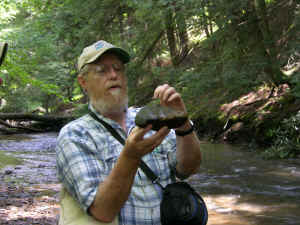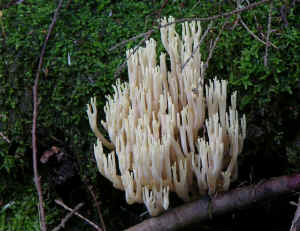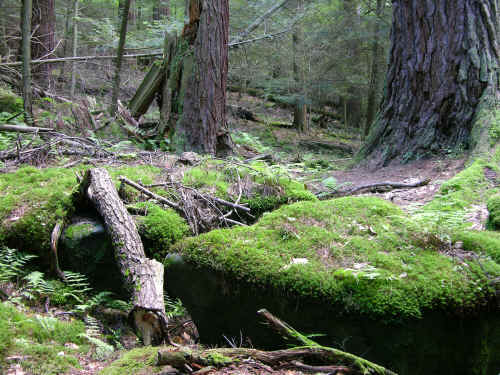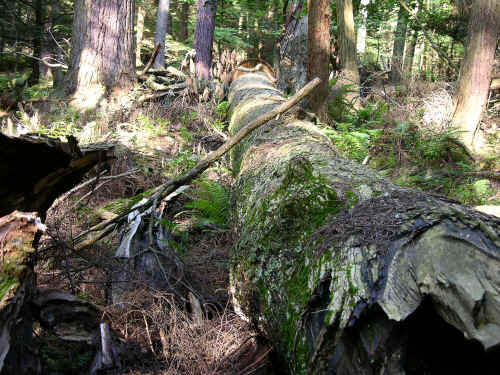| Moss
Walk at Cook Forest, PA |
Edward
Frank |
| Jul
16, 2006 19:57 PDT |
Moss Walk - Cook Forest
Saturday, July 15, 2006, I attended a "Moss Walk" at
Cook Forest State Park.
The program blurb read: "Ever wonder what kinds of mosses
and liverworts
grow in the Forest Cathedral? Can these often overlooked
bryophytes tell us
about the health of the environment? Join our local molds,
spores, and
fungus expert, Dr. Harold "Hank" Webster, Penn State
Dubois biology
professor, on an exploratory walk through the Forest Cathedral
to identify
these tiny members of the forest community. Program starts at
the Log Cabin
Inn Environmental Learning Classroom; magnifying glasses will
come in
handy."

Dr. Harold Webster
I had first
met Dr. Webster at the Wapiti Audubon Society meetings, but had
not know he was an expert in mosses. ENTS were well represented
at the talk
wit Dale Luthringer, Anthony Kelly, (and Jacqui Noel), Carl
Harting, and
Myself. I knew very little about mosses aside from what I had
read in some
field books. Most of the references I had found when discussing
this topic
earlier this spring were either too simplistic or too
complicated to
understand without an adequate background.
Several of us arrived early and Dr. Webster and us scouted
several areas
near the Log Cabin Inn nature center. The program started at
3:00 with
those of us listed above and three other people from the general
public -
this was really a better response than Hank had expected. He
went over the
life cycle of the mosses and liverworts briefly. They both can
reproduce
sexually and asexually. The characteristics of various
reproductive stages
and growths are often important in the differentiation of
different species.

Coral Fungus against a backdrop of moss
After a
brief introduction we all headed out into the field. We didn't
travel far because mosses and liverworts grow everywhere. With
everyone
using hand lenses, Dr. Webster showed us examples of a number of
different
species of mosses and liverworts and pointed out distinctive
characteristics. Many could only be broken down to genera in the
field
using hand lenses. Microscopic work would be needed to
specifically
identify the species. It was really useful to have someone point
out in the
field using actual specimens various physical characteristics
present in the
specimens. The entire walk embraced a few hundred yards and we
looked at a
couple dozen different mosses and liverworts.
After the talk, all of the ENTS accompanied Dr. Webster to the
vicinity of
the Seneca Pine in the Forest Cathedral area to look at the
thick moss mats
present there. There are boulders in the area covered by moss.
It is a
larger species, and if I read my notes correctly, Polytrium
ohioense I had
chosen this destination for the group because of the large
amount of moss
present, the fact that it was in an old growth area, and the
existence of
large sandstone blocks, and fallen logs in various states of
decay. I
wasn't sure about the diversity of species, just that there was
quite a bit
of moss.

Moss topping boulders under the Seneca Pine
I learned a
many things and have a better perspective on mosses and
liverworts. Still, as with all trips of this nature, more
questions were
raised than answered. Someone ask "Howe old were these moss
mats atop the
boulders?" Good question. Mosses are non-vascular, spore
producing
organisms. They do not have true roots. If you look at an
individual plant
you can see the evidence of annual growth. These examples were
perhaps
three inches in length. The living portion of the organism was
perhaps 8 to
ten years old. The thing is however, that the bottom portion of
the moss
was in the process of decaying at the same time as the upper
portion was
growing. The actual height of the moss was dependant of the
balance of the
rate of decay and growth. This particular
organism may have been alive
for decades, hundreds of years, or even thousands, but the
portions of this
organism living at those times have since decayed. So how old
are they?
The rock likely was not covered by moss 10,000 years ago because
of the
periglacial climate present in the area. However soon after the
glaciers
began to retreat moss could have first grown on this rock. Has
it died and
repopulated the rock since that time? Maybe. periods of drought
may have
hurt the moss, but are unlikely to have killed it. The tops of
the boulders
are typically a xeric environment, but moss that has been dried
for years
will start to grow again when wetted. Forest fires could have
burned the
moss at some point in the past. Clearly the environment and moss
growths
seem to be in some form of a long-term steady state. This is an
area of the
forest undisturbed by logging. The little moss growing on that
rock could
be a colony of individuals who are each older than the oldest
pines in the
forest. The Seneca Pine giving shade to the rock could be
nothing but a
fledgling with respect to the ages of the moss. Hank observed
that the
mosses are generally not subject to browsing by insects and
deer. That is
true they are not commonly eaten. Over the 500 million years of
their
existence they have evolved a series of nasty chemicals that
make them taste
bad. He said there was one chemical formally known only to occur
in
spiders, that was found to occur is some moss species.
I wonder if they may also have some anti-plant characteristics
also. There
typically are several species of moss, liverworts, and lichen
growing in a
patch on the forest floor. There are a few tiny sprouts of red
maple or
hemlock among the moss, but these rarely are more than a
fraction of an inch
in height. If were easy to colonize within these mats of moss on
rocks, or
on the forest floor, why were they not overwhelmed by
angiosperms long ago?
On some boulders hemlock has managed to sprout. On these rocks
the moss has
died. The surface is covered by a thin layer of soil, followed
by debris of
fine branches, hemlock needles, and cones beneath the trees.
What has
killed the moss? Alleopathy is a characteristic of hemlock. It
gives off
chemicals that suppress the growth of other plants. This likely
has killed
the moss. The boulders have a limited amount of soil, difficult
rooting,
and are subject to drying. Those trees that do survive atop the
boulders
will grow to a certain height be fore stopping. They are
suppressed by
these limitations. That is why trees growing atop a series of
rocks all may
seem similar in height, even though they obviously vary in age.
Back to the
hemlock on the boulders. This hemlock killed the moss on a
particular rock.
If it is blown over or dies, the rock potentially could be
recolonized by
moss again. Perhaps this cyclical process has restarted the moss
again and
again, resetting the age of the mat.
There are dozens of microenvironments that affect the growth of
a particular
species of moss, as well as the circumstance of first come first
served. It
would be an impossible task to try to delineate each of these
micro
environments that may only be a few centimeters in size. On the
original
field trip there was a moss that typically grew on rotting logs,
Here on a
shaded sandstone cliff was the same species covering a vertical
face. Why?
Dr. Webster is retiring in a year. perhaps then he will have
time to do
some needed field work in the Cook Forest State Park.
Bryologists are not a
common specialty.

Fallen Cucumber Tree after 18 months
After leaving this area we hiked down to the potentially 400+
year old
fallen cucumber tree. Since its fall a year and a half ago, the
decay
process has started. Moss now grows on the western side of the
fallen log
almost to the top. Moss grows along some of the branch whorls
near the top
of the tree. The smaller branches are beginning to decay. In the
center of
a hollow in the fallen trunk, what last year was light reddish
slightly
decayed wood, has now turned dark brown and become finer. Small
plants are
starting to sprout in the humus. I will post photos later. Dr.
Webster
identified some of the moss species as: Dicranus montanum,
Pltygyrins
repens, and Mnium sp. (again my spelling may be off). Also
present were
slime molds and a number of unidentified crustose lichens. Fro
here we
headed back to the parking lot and went for dinner. Dr. Webster
did another
program at the campground later that evening.
One website that has some nice photos of bryophytes is:
http://wisplants.uwsp.edu/bryophytes/index.html
In the way of field guides for mosses, there are few worth
while. A recent
book has been published called: 50 Outstanding
Mosses and Liverworts of
Pennsylvania and Nearby States by Susan Munch looks to be a good
starting
point for people interested in the field. This book with photos
has just
been published. Dr. Munch is a professor at Albright College in
Reading
Pennsylvania. Mosses are generally widely distributed. Dr.
Webster talked
of one he had collected in Barrow Alaska and also in the steps
of an Aztec
pyramid in Mexico City. So it would be appropriate for people
across the
eastern US. It can be ordered from the author at: sus-@alb.edu
I haven't ordered my copy yet, so I don't know any more info
that that.
Ed Frank
|
| RE:
Moss Walk at Cook Forest, PA HWA |
Will
Blozan |
| Jul
17, 2006 07:55 PDT |
Ed,
Awesome description of the walk and new insights! I enjoy walks
with Dr.
Frelich as he seems to know a ton about mosses. I know they can
tell so much
about the forest, but somehow my gaze is turned upwards...
The idea of ancient communities of moss mats on boulders (and
logs) is
interesting to think about. Their presence in the forest should
be perceived
no less important than that of the ancient tree canopy. The
interplay and
shade/moisture relationship may be more key to the function of
the system
than we now know.
I have great concern for the eastern hemlock forests and the
role that
species plays in so many ecosystems. The loss of the deep shade
to hemlock
woolly adelgid will undoubtedly disrupt the balance of the
ancient moss
communities and disturb the seeding beds of those species that
tend to root
on shaded, moist organic material, be it moss mats or wet logs
(yellow and
black birch, rosebay rhododendron, eastern hemlock, etc.).
In the wake of hemlock woolly adelgid in the southern
Appalachians the sheer
mass of the giant trees will lead to mechanical destruction of
many of the
remaining non-hemlock trees as the huge snags snap and fall. In
some areas,
the forest floor will then be a sunny, desiccated and disturbed
environment-
a rich seedbed for exotic and early successional plants. The
old-growth
system will be lost forever- human disturbance leaving a
permanent impact.
Finding out more about the ecological significance of these moss
ecosystems
could help with funding to preserve the hemlock canopy harboring
the
conditions for their perpetuation.
Will
|
| Re:
Moss Walk at Cook Forest, PA |
Fores-@aol.com |
| Jul
17, 2006 08:15 PDT |
Ed:
It never ceases to amaze me how much a thick carpet of moss adds
to enjoying
the woods. In addition to all of its incredible water holding
capacity and
providing breeding and living habitat for dozens of amphibians
...at least
once a year I find myself taking off my boots on a hot midsummer
day just to
massage my feet in a moss "shag" carpet 3 or 4 inches
thick. There is some
sort of guilty pleasure in savoring something in the woods that
could never be
reproduced indoors.
Russ |
| Re:
Moss Walk at Cook Forest, PA |
Lee
E. Frelich |
| Jul
17, 2006 09:10 PDT |
Ed:
Sounds like an interesting hike. I noticed many of the same
species when I
was there.
The correct spellings are:
Polytrichum ohioense (tallest moss in the park, with some stems
reaching 6
inches).
Dicranum montanum
Platygyrium repens
Mnium sp.
Regarding the moss mats on rocks, I believe there would be a
lichen
successional stage that may preceed the moss in many cases. In a
forest
with white pine, fires were probably common and would burn many
of the moss
mats once or twice per century, animals may strip the moss off
the rocks,
and not all moss species are extremely shade tolerant and heavy
shade can
kill some species, as can smothering from litterfall (especially
broadleaf
litterfall). If a dense clump of smaller trees occurs directly
over a rock,
the moss thickness will decline, or the moss may disappear. A
given rock
may have an old tree above it for several centuries, and the
shade from the
high canopy may not be so dark, allowing moss mats to thicken.
Moss mats
on rocks are probably more dynamic over time than you seem to
think. In
northern MN moss mats a foot thick come and go on a time scale
of 1-2
centuries as the forest responds to fires.
Lee
|
| Re:
Moss Walk at Cook Forest, PA |
Michele
Wilson |
| Jul
18, 2006 06:08 PDT |
Nice report, Ed;
I would've enjoyed that walk & learning experience. I always
stop for a
moment to admire mats of moss, etc. as I do my forest work and
do speculate
on the effects of the forest floor microsites via thinning out
the forest.
I wonder if there are any invasive species of mosses and
liverworts also
interrupting the matted flow.
Michele
|
| RE:
Moss walk at Cook Forest |
Edward
Frank |
| Jul
18, 2006 20:14 PDT |
Lee,
Thanks for your reply. It would be nice to talk with you in
person in the field while we looked at some of these things.
These comments are certainly worth further discussion. I am not
sure I agree with your comments however.
Forest Fires: Clearly this is most likely the limiting factor
with respect to the maximum age of the moss mats. The age of
those fire events could be quite variable however. These mats in
Cook Forest for example are in an area that is not frequently
subject to fire events, unlike some other ares where frequent
fires dominate the ecology. There haven't been any fire recorded
in this area for at least 100 plus years. There may have been
some fires at Cook in some area in the late 1800's if I recall
comments Dale made one time, but those were not in this area.
I don't know when the last fire was in the area of the Seneca
Pine. There are trees like beech and cucumber which are less
likely to survive forest fires, compared to the white pines,
which are quite old, perhaps in excess of 30o to 400 years in
the area. This does not mean that a fire did not occur during
that time, but certainly there was not any major conflagration
like you see on the news occurring in the western United States.
A major fire would definitely wipe out any moss mats in its
path. Smaller fires jump from place to place and may skip
portions of the forest. Smoldering fire in the litter zone and
small underbrush potentially might not affect the mats isolated
atop larger boulders. There is a group of pine trees in the
Forest Cathedral Area in the 400 plus year range. Perhaps a
major event opened the forest at that time. White pine require
open areas to grow effectively. This may have been a major
forest fire, it which case the maximum age of the moss mats
would be in the same time frame as the maximum age of these
trees. If it were a major blowdown that opened the forest, then
that is a different story. I doubt that the blowdown would
itself destroy the moss mats and any that had not since been
destroyed by fire could predate the oldest of the trees in the
area.
Has there been a fire event sine this 400 year old event? I have
no way to tell at this point. Using Occam's Razor, in which the
simplest explanation is the most likely, then lacking any
evidence of a fire, I would be forced to conclude that there has
not been any. Therefore, if this assumption is correct then the
maximum age of the moss mats would be 400 years or greater since
the last restart. I am not convinced of your assentation of
"In a forest with white pine, fires were probably common
and would burn many of the moss mats once or twice per
century."
Lichens: You have suggested that lichens would be part of a
typical succession pattern for the moss mats. Initially after
glaciation the first growth on a rock would be lichens. Crustose
are the first to form. I am not sure this is true for rocks that
have become bare as a result fire or other cause. if you look at
rocks turned over by road construction, lichens do grow, but
they are accompanied in the same time frame as the mosses. These
rocks are not in isolation. There is often bits of soils still
attached. There is organic matter collecting in pockets from
fallen pine needles and leaves. All of these give the moss a
chance to grow. I am sure there is a successional sequence, and
it would be interesting to figure out its pattern, but in many
cases I think succession on these boulders are driven more so by
opportunistic events than strict succession.
Animals stripping moss from rocks: I don't know why they would
do this. But it is not impossible. So if we would consider that
evidence of this stripping of the moss mat from a boulder would
be detectable for say 1 year. (Actually it is likely more like a
dozen years - just guessing). Then the reciprocal of the
frequency of the stripped moss boulders among the total number
of moss covered boulders would equal the mean time in years per
animal disturbance. in effect: If 1 boulder among 500 were
striped by animals in a given year, then the average time for
any particular boulder to be stripped by animals would be 500
years. This does not indicate the residence time for a
particular boulder, that could be much higher or lower, but the
average time for the population of the boulders. Now in the area
of the Seneca Pine there are hundreds of boulders. I would need
to do a survey, but I have not seen any boulders that appear to
have been stripped by animals. The reciprocal of that is
infinity, isn't realistic, because I haven't surveyed all of the
rocks in the area. But it is my impression that the time between
stripping incidents by animals will be extremely large and not a
limiting factor in the maximum age of the moss mats.
Variations in light: Moss grows well in the shade and it grows
well in the light. One particular species seems to be the climax
species of the moss mats. It is growing well in brightly lit
areas and in darkly shaded areas. I would think this moss would
develop a mat regardless of the light conditions. If
moss succession is involved, perhaps there would be different
paths, but the widespread distribution of this moss in various
areas, substrates, and light conditions suggests mats made of
this moss is the end result.
Dynamic: I think the mats are dynamic, getting thicker and
thinner with varying conditions, but the question is not whether
they get thicker or thinner, but whether they are continuous
over a long period of time, and how long is that time period?
There are a number of disturbance types that could affect the
growth, death or recovery of the moss mats. There are fire
disturbance - how long do they take to recover and how does that
process work? Blowdowns - how does this affect existing mats and
how do they recover, change, or decline as a consequence of the
blowdown? How do man-made disturbances like timbering operations
affect the moss mats and how does this compare to changes in the
moss mats in areas affected by natural disturbances? What are
the effect of wide scale overstory loss from hemlock wooly
adelgid? These are all subjects for enquiry.
There are limiting factors in the age of the moss mats. Among
them I see fire, death by alleopathy (hemlock example in initial
post), and perhaps smothering by leaf litter as suggested in
your notes. Acid rain and other pollution surely are also
adversely affecting the mosses in the forest.
Ed Frank
|
|